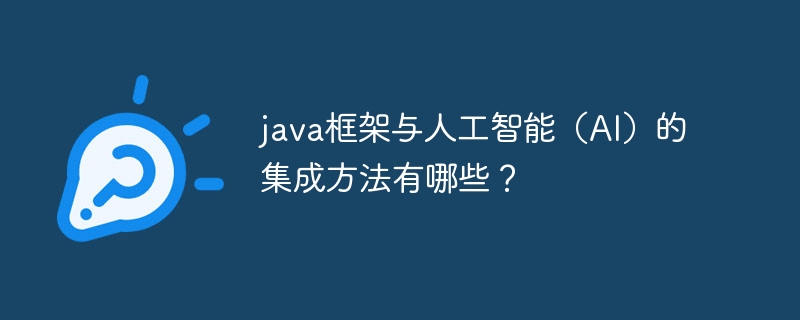java框架与人工智能(AI)的集成方法有哪些?
时间:2024-07-19 19:12:25 367浏览 收藏
怎么入门文章编程?需要学习哪些知识点?这是新手们刚接触编程时常见的问题;下面golang学习网就来给大家整理分享一些知识点,希望能够给初学者一些帮助。本篇文章就来介绍《java框架与人工智能(AI)的集成方法有哪些?》,涉及到,有需要的可以收藏一下
Java 框架可通过以下三种方式集成 AI 技术:通过 API 访问、使用 Java 客户端库以及采用开放标准。API 访问可轻松使用 AI 提供商提供的各种 AI 服务。Java 客户端库允许直接与 AI 服务交互,简化了集成过程。开放标准如 Protocol Buffers 或 gRPC 可实现与提供商无关的 AI 集成。

Java 框架与人工智能 (AI) 的集成方法
随着 AI 在企业中的普及,将 AI 技术集成到 Java 应用程序变得越来越重要。以下是常见的方法:
1. 通过 API 访问
使用 AI 提供商提供的 API,如 Google Cloud AI Platform 或 AWS SageMaker,可以轻松地访问各种 AI 服务,包括机器学习、自然语言处理和计算机视觉。
import com.google.cloud.aiplatform.v1.EndpointServiceClient;
import com.google.cloud.aiplatform.v1.EndpointServiceSettings;
import com.google.cloud.aiplatform.v1.PredictRequest;
import com.google.cloud.aiplatform.v1.PredictResponse;
import java.io.IOException;
public class AiApiExample {
public static void main(String[] args) throws IOException {
// Set the endpoint URI
String endpoint = "YOUR_ENDPOINT_URI";
// Initialize the client
EndpointServiceSettings settings = EndpointServiceSettings.newBuilder().build();
EndpointServiceClient client = EndpointServiceClient.create(settings);
// Prepare the prediction request
PredictRequest.Builder requestBuilder = PredictRequest.newBuilder();
requestBuilder.setEndpoint(endpoint);
// Add the input data here
PredictRequest request = requestBuilder.build();
// Perform the prediction
PredictResponse response = client.predict(request);
// Process the prediction response
// ...
}
}2. 使用 Java 客户端库
一些 AI 提供商提供 Java 客户端库,允许直接与 AI 服务交互,从而简化了集成。
import com.google.cloud.automl.v1beta1.ImageClassificationPredictResponse;
import com.google.cloud.automl.v1beta1.PredictRequest;
import com.google.cloud.automl.v1beta1.PredictRequest.ParamsEntry;
import com.google.cloud.automl.v1beta1.PredictResponse;
import com.google.cloud.automl.v1beta1.PredictionServiceClient;
import com.google.cloud.automl.v1beta1.PredictionServiceSettings;
import java.io.IOException;
import java.nio.file.Paths;
public class AiClientLibExample {
public static void main(String[] args) throws IOException {
// Set the endpoint URI
String endpoint = "YOUR_ENDPOINT_URI";
// Set the prediction input
String filePath = "YOUR_IMAGE_FILE_PATH";
// Initialize the client
PredictionServiceSettings settings =
PredictionServiceSettings.newBuilder().build();
PredictionServiceClient client = PredictionServiceClient.create(settings);
// Prepare the prediction request
PredictRequest.Builder requestBuilder = PredictRequest.newBuilder();
requestBuilder.setEndpoint(endpoint);
requestBuilder.putParams(
"score_threshold", ParamsEntry.newBuilder().setDoubleValue(0.5).build());
requestBuilder.addImage(Paths.get(filePath));
PredictRequest request = requestBuilder.build();
// Perform the prediction
PredictResponse response = client.predict(request);
// Process the prediction response
for (ImageClassificationPredictResponse prediction :
response.getPayloadList().expandList().getImageClassification()) {
// Process the prediction result
// ...
}
}
}3. 使用开放标准
如 Protocol Buffers 或 gRPC,可用于与 AI 服务通信。通过这种方法,可以实现与提供商无关的 AI 集成。
import com.google.protobuf.ByteString;
import io.grpc.ManagedChannel;
import io.grpc.ManagedChannelBuilder;
import io.grpc.StatusRuntimeException;
import org.tensorflow.framework.TensorShapeProto;
import org.tensorflow.framework.TensorProto;
import org.tensorflow.serving.apis.Model;
import org.tensorflow.serving.apis.PredictRequest;
import org.tensorflow.serving.apis.PredictResponse;
import org.tensorflow.serving.apis.PredictionServiceGrpc;
public class AiOpenStandardExample {
public static void main(String[] args) throws Exception {
// Set the server address
String serverAddress = "YOUR_SERVER_ADDRESS";
// Connect to the server
ManagedChannel channel =
ManagedChannelBuilder.forTarget(serverAddress).usePlaintext().build();
PredictionServiceGrpc.PredictionServiceBlockingStub stub =
PredictionServiceGrpc.newBlockingStub(channel);
// Prepare the prediction request
TensorProto input = TensorProto.newBuilder()
.addDtype(TensorProto.DataType.DT_FLOAT)
.addShape(TensorShapeProto.getDefaultInstance())
.addFloatVal(1.0f)
.addFloatVal(2.0f)
.build();
PredictRequest request = PredictRequest.newBuilder()
.setModel(Model.newBuilder().setName("YOUR_MODEL_NAME").build())
.putInputs("input1", input)
.build();
// Perform the prediction
try {
PredictResponse response = stub.predict(request);
// Process the prediction response
TensorProto output = response.getOutputsMap().get("output1");
float prediction = output.getFloatVal(0);
// ...
} catch (StatusRuntimeException e) {
// Handle error
e.printStackTrace();
}
}
}今天带大家了解了的相关知识,希望对你有所帮助;关于文章的技术知识我们会一点点深入介绍,欢迎大家关注golang学习网公众号,一起学习编程~
-
501 收藏
-
501 收藏
-
501 收藏
-
501 收藏
-
501 收藏
-
136 收藏
-
420 收藏
-
369 收藏
-
363 收藏
-
446 收藏
-
332 收藏
-
222 收藏
-
100 收藏
-
260 收藏
-
154 收藏
-
360 收藏
-
306 收藏
-

- 前端进阶之JavaScript设计模式
- 设计模式是开发人员在软件开发过程中面临一般问题时的解决方案,代表了最佳的实践。本课程的主打内容包括JS常见设计模式以及具体应用场景,打造一站式知识长龙服务,适合有JS基础的同学学习。
- 立即学习 543次学习
-

- GO语言核心编程课程
- 本课程采用真实案例,全面具体可落地,从理论到实践,一步一步将GO核心编程技术、编程思想、底层实现融会贯通,使学习者贴近时代脉搏,做IT互联网时代的弄潮儿。
- 立即学习 516次学习
-

- 简单聊聊mysql8与网络通信
- 如有问题加微信:Le-studyg;在课程中,我们将首先介绍MySQL8的新特性,包括性能优化、安全增强、新数据类型等,帮助学生快速熟悉MySQL8的最新功能。接着,我们将深入解析MySQL的网络通信机制,包括协议、连接管理、数据传输等,让
- 立即学习 500次学习
-

- JavaScript正则表达式基础与实战
- 在任何一门编程语言中,正则表达式,都是一项重要的知识,它提供了高效的字符串匹配与捕获机制,可以极大的简化程序设计。
- 立即学习 487次学习
-

- 从零制作响应式网站—Grid布局
- 本系列教程将展示从零制作一个假想的网络科技公司官网,分为导航,轮播,关于我们,成功案例,服务流程,团队介绍,数据部分,公司动态,底部信息等内容区块。网站整体采用CSSGrid布局,支持响应式,有流畅过渡和展现动画。
- 立即学习 485次学习
